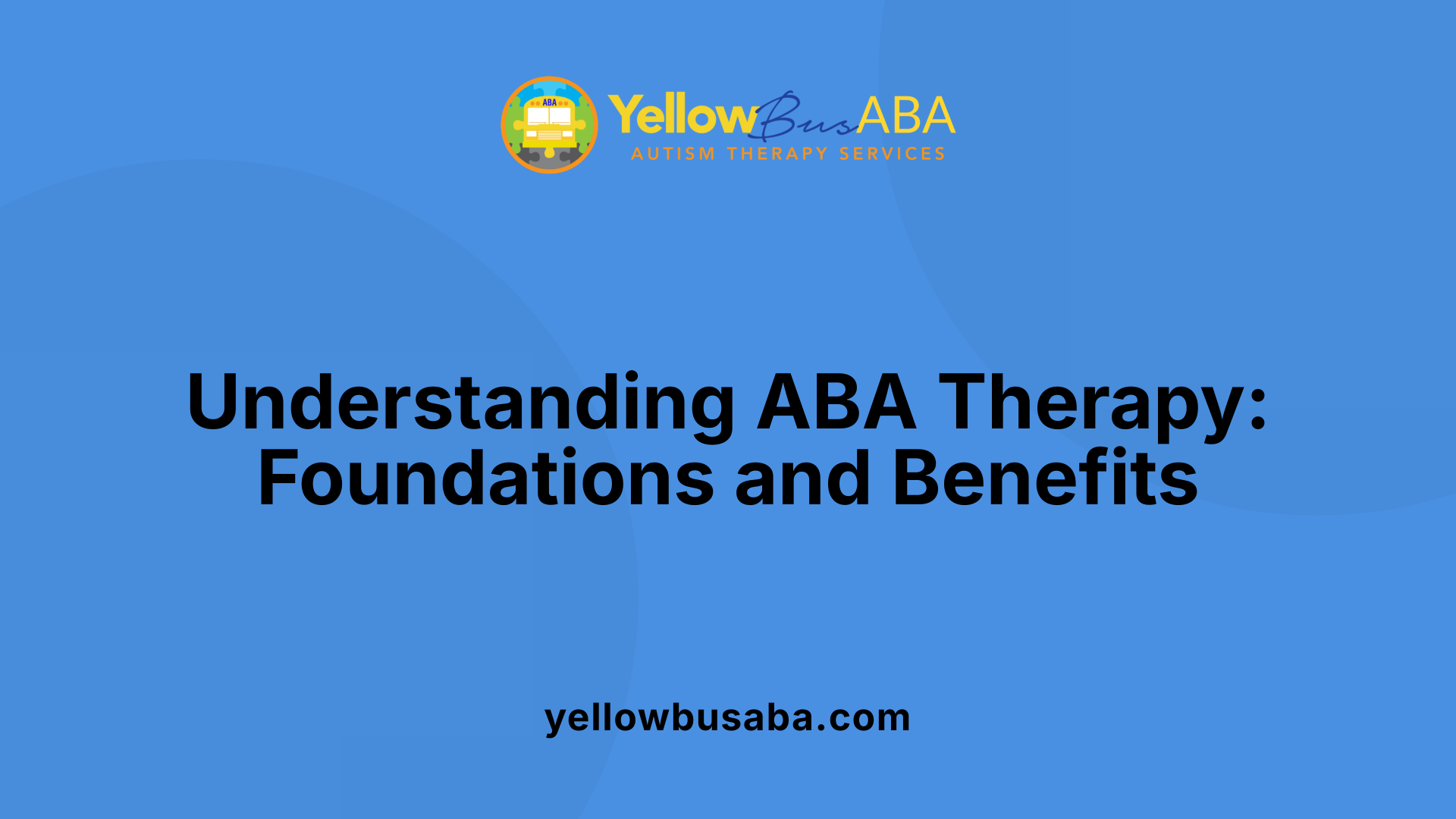Understanding ABA Therapy for Young Children
Applied Behavior Analysis (ABA) therapy stands as a scientifically validated approach to assist preschool-aged children diagnosed with autism spectrum disorder. Rooted in the principles of behavior science, ABA focuses on developing essential life and social skills while mitigating challenging behaviors through individualized programs crafted by certified professionals. This article unfolds the key elements of ABA therapy, its implementation in early childhood, and the benefits it offers to children and their families.
What is ABA Therapy and How Does it Help Children with Autism?

Definition of ABA
Applied Behavior Analysis (ABA) therapy is a structured, science-based treatment aimed at promoting positive behaviors and reducing harmful ones in individuals with autism. It uses principles of learning and behavior management to help children gain important life skills.
Behavioral Science Basis
ABA therapy is grounded in behavioral science, specifically the analysis of antecedents (triggers), behaviors, and consequences (A-B-C model). By understanding these components, therapists tailor interventions to the unique needs of each child, encouraging learning through positive reinforcement.
Target Outcomes for Children with Autism
ABA programs focus on improving communication, social interaction, self-care, play, motor, and academic skills. Additionally, it addresses challenging behaviors like tantrums, aggression, and self-injury. The goal is to foster independence, emotional regulation, and social integration, ultimately enhancing the child's quality of life.
Individualization and Focus Areas
Each ABA therapy program is personalized by a Board Certified Behavior Analyst (BCBA) to meet a child's specific developmental goals and needs. Therapies are adaptable and can be delivered across various environments such as home, school, and community settings. The individualization ensures that interventions align with the child's strengths and challenges.
Role of Early Intervention
Starting ABA therapy early, often as young as 2 to 3 years old, is crucial for maximizing developmental gains. Early and intensive interventions—sometimes more than 20 hours per week—are linked to significant improvements in language, cognition, and social skills, which can reduce the need for future special services.
ABA therapy, through its evidence-based and individualized approach, provides vital support to children with autism, helping them develop essential skills and lead more fulfilling lives.
Who Provides ABA Therapy and What Qualifications Do They Hold?

Professionals delivering ABA
ABA therapy is delivered primarily by licensed and trained professionals specialized in behavior analysis. The most recognized providers are Board Certified Behavior Analysts (BCBAs), who are responsible for designing, supervising, and overseeing individualized ABA programs.
Qualifications of Board Certified Behavior Analysts (BCBAs)
BCBAs typically hold a master's degree in Applied Behavior Analysis or a related field. Their educational background includes completing a verified course sequence specified by the Behavior Analyst Certification Board (BACB).
Certification and supervised experience requirements
To earn BCBA certification, candidates must pass a comprehensive exam administered by the BACB. Additionally, they are required to complete extensive supervised fieldwork — usually ranging between 1,500 and 2,000 hours — under the guidance of an experienced BCBA. Licensure requirements may vary by state but generally align closely with these certification standards.
Role of Registered Behavior Technicians (RBTs) and other licensed professionals
Registered Behavior Technicians (RBTs) are trained behavior technicians who provide direct therapy to individuals under BCBA supervision. They implement ABA interventions but do not independently develop treatment plans. Other licensed behavioral health professionals, such as licensed counselors or social workers with supplemental ABA training, may also deliver ABA services in collaboration with BCBAs.
This structured system ensures that ABA therapy is delivered by highly qualified practitioners, combining rigorous education, certification, and supervised experience to guarantee effective and ethical treatment for individuals receiving ABA.
Primary Goals of Behavioral Analysis in Autism Therapy

Increasing positive, adaptive behaviors
Applied Behavior Analysis (ABA) therapy prioritizes promoting helpful and adaptive behaviors in children with autism. These include essential skills such as communication, social interactions, self-care, play, and academic abilities. By focusing on these areas, ABA helps children engage more effectively with their environment and peers, fostering improved learning and social participation.
Reducing challenging or harmful behaviors
ABA also works to decrease interfering behaviors like aggression, tantrums, and self-injury. Through careful analysis of antecedents and consequences, therapists develop individualized behavior intervention plans that address the root causes of these behaviors. This reduction supports safety and facilitates better learning opportunities.
Building communication, social, and daily living skills
Therapy targets foundational skills like attention, imitation, and following instructions, which support development across multiple domains. Through methods such as positive reinforcement and prompting, ABA encourages acquisition of verbal and non-verbal communication, social skills like sharing and turn-taking, and independence with daily routines.
Using data-driven, individualized strategies
Progress is closely monitored through ongoing data collection and assessment led by Board Certified Behavior Analysts (BCBAs). This systematic tracking allows for tailored interventions adjusted to each child’s unique needs and developmental goals, ensuring therapy remains effective and relevant.
Supporting independence and social integration
Ultimately, ABA therapy aims to enhance quality of life by building skills that foster independence and positive social integration. By increasing adaptive behaviors and decreasing challenging ones, children can participate more fully at home, school, and in the community.
| Goal | Description | Techniques Involved |
|---|---|---|
| Increase positive behaviors | Enhance communication, social, and daily living skills | Positive reinforcement, modeling, prompting |
| Decrease challenging behaviors | Reduce tantrums, aggression, self-injury | Behavior intervention plans, ABC analysis |
| Build foundational skills | Attention, imitation, following instructions | Discrete Trial Training (DTT), natural environment training (NET) |
| Individualize therapy | Tailored goals and strategies per child | Data collection and BCBA supervision |
| Promote independence and integration | Support functional skills and social participation | Consistent reinforcement at home and community |
Techniques Commonly Employed in ABA Therapy for Autism

What techniques are commonly used in ABA therapy for autism?
Applied Behavior Analysis (ABA) therapy utilizes a variety of proven techniques to promote skill development and reduce challenging behaviors in individuals with autism. These methods are tailored to each child's unique needs and aim to encourage learning through structured and natural environments.
Positive Reinforcement: This core technique rewards desirable behaviors immediately to increase their likelihood of repetition. For example, giving praise or a favorite item when a child correctly follows a command.
Discrete Trial Training (DTT): DTT is a highly structured teaching method where skills are broken into small, manageable steps. Each trial includes a prompt, response, and reinforcement, enabling clear, focused learning.
Modeling and Prompting: ABA therapists demonstrate desired behaviors (modeling) and provide prompts or cues to guide the learner. Over time, prompts are gradually faded to encourage independence.
Picture Exchange Communication System (PECS): PECS uses pictures to help nonverbal children communicate by exchanging images representing needs or choices, fostering early communication skills.
Behavior Chaining: This breaks complex tasks (like brushing teeth) into smaller sequential steps. Each step is taught and reinforced in order, helping the child master the full behavior over time.
Natural Environment Training and Play-Based Methods: Approaches such as Pivotal Response Treatment (PRT) and the Early Start Denver Model (ESDM) use play and natural settings to teach skills through motivation and child-led activities, encouraging generalization of skills.
Together, these techniques form a comprehensive toolkit that behavior analysts and therapists employ to create individualized and effective ABA programs. They focus on meaningful skill acquisition and behavior change while supporting positive social interactions and enjoyable learning experiences.
Individualized ABA Programs: Assessment and Tailored Intervention

How Are ABA Therapy Programs Individually Assessed by BCBAs?
ABA therapy programs start with a thorough assessment conducted by a Board Certified Behavior Analyst (BCBA). This evaluation considers various factors such as communication skills, social interaction, behavior patterns, and sensory processing. The BCBA uses a comprehensive approach, often referencing the "autism wheel" to map interconnected developmental characteristics. This assessment forms the foundation of a personalized intervention plan.
What Role Does the A-B-C Model Play in Individualizing Treatment?
The A-B-C (Antecedent-Behavior-Consequence) model is central to ABA practice. By identifying environmental triggers (antecedents), the exhibited behavior, and the consequences that follow, therapists understand what motivates or maintains specific behaviors. This analysis helps tailor strategies that reinforce beneficial behaviors and reduce harmful ones, ensuring interventions are both effective and respectful of the child's needs.
How Are Personalized Treatment Plans Developed and Implemented?
Based on the initial assessment and A-B-C analysis, the BCBA crafts individualized treatment plans targeting goals in areas like communication, social skills, self-care, and academics. These plans incorporate evidence-based techniques such as positive reinforcement, prompting, and shaping. Treatment approaches—including methodologies like Discrete Trial Training (DTT) or Pivotal Response Treatment (PRT)—are selected to suit the child's unique learning style and developmental stage.
How Is Progress Tracked Through Continuous Data Collection?
Data collection is a vital component of ABA therapy. Therapists systematically record observations and measure the child's responses to interventions across sessions. This ongoing collection allows for close monitoring of progress toward specific goals, ensuring transparency and objective evaluation of outcomes.
Why Are Adjustments to Interventions Necessary?
ABA programs are dynamic and evolve in response to the data collected. If progress stalls or challenges arise, the BCBA reviews the data, reassesses the child's needs, and modifies the treatment plan accordingly. This flexibility ensures that interventions remain relevant, supportive, and optimized to promote the child’s advancement in skills and overall quality of life.
Integration of ABA Therapy in Preschool Settings
Where Is ABA Therapy Provided?
ABA therapy is versatile and can be delivered effectively in a variety of settings tailored to a child's needs. Common environments include the home, preschool classrooms, and wider community areas. Providing ABA in these everyday settings helps children learn and practice skills in the places where they naturally live and play.
Collaborating for the Best Outcomes
Successful ABA programs in preschools rely on strong collaboration between educators, therapists, and families. This teamwork ensures that learning strategies are consistent, goals are shared, and everyone supporting the child is on the same page. Regular communication helps address challenges promptly and fosters a nurturing learning environment.
Consistency and Data Sharing Are Essential
Consistent implementation of ABA interventions across all settings is vital to maximize progress. Therapists and educators collect data on a child's performance which is regularly reviewed to adjust programs as the child develops. Open data sharing promotes transparency and helps tailor therapy to meet each child's evolving needs.
Integrating Other Therapies
ABA does not work in isolation. Many preschools integrate occupational, speech, and physical therapy with ABA to address the whole child's development. These services complement each other by targeting different skill areas, such as mobility, communication, and fine motor skills, providing comprehensive support.
Supporting Sensory Needs and Academic Readiness
Preschools serving children with autism offer structured environments that recognize sensory sensitivities. ABA programs often include strategies to help children adapt comfortably to sensory input. Moreover, these settings prepare children academically by promoting readiness skills—laying a foundation for future learning and social success.
ABA therapy's integration in preschool is a dynamic, team-oriented process that supports a child's growth across many dimensions while respecting their individual needs and differences.
Early Intervention and Its Impact on Developmental Outcomes
Why Start ABA Therapy Early, Around Ages 2–3?
Early intervention with ABA therapy, starting as young as 2 to 3 years, is crucial because the developing brain is more adaptable to learning new skills. Beginning therapy at this age helps children with autism build foundational communication, social, and self-care skills that support long-term growth.
What Are the Benefits of Early Intensive ABA?
Early intensive ABA therapy, typically involving more than 20 hours per week during the first few years, has been shown to lead to significant developmental gains. These gains include improvements in language, cognition, socialization, and daily living skills. Intensive therapy helps accelerate skill acquisition and behavior improvements more effectively than less frequent interventions.
How Does Early ABA Reduce Future Special Service Needs?
By addressing core challenges early with tailored ABA programs, children often require fewer specialized services down the line. Early gains in independence and communication can reduce the need for more intensive supports as they grow older, promoting a smoother transition into school and community settings.
How Is Therapy Duration and Intensity Tailored?
ABA is individualized to each child's unique needs, developmental stage, and progress. The duration and intensity of therapy may vary, with some children benefiting from several hours a week while others require more comprehensive programs. Ongoing assessment by a Board Certified Behavior Analyst (BCBA) ensures adjustments maximize effectiveness.
How Does ABA Support Emotional Regulation and Coping?
In addition to skill development, early ABA sets a foundation for better emotional regulation. Children learn coping strategies to manage stress, frustration, and anxiety, improving their ability to function in social and learning environments. This holistic support fosters greater independence and quality of life.
| Aspect | Explanation | Impact on Child |
|---|---|---|
| Early Start (ages 2–3) | Capitalizes on brain plasticity for effective learning | Builds foundational skills early |
| Intensive Therapy (>20 hrs/wk) | Accelerates developmental gains in multiple domains | Rapid improvements in communication & behavior |
| Future Needs Reduction | Early skill mastery decreases reliance on special education services | Greater independence over time |
| Individualized Approach | Therapy tailored to child's abilities and goals with ongoing data-driven adjustments | Personalized, effective intervention |
| Emotional Regulation Support | Teaches coping strategies to handle stress and emotional challenges | Enhances social participation and learning |
Benefits of ABA Therapy Beyond the Child: Family and Caregiver Support
How Does ABA Therapy Reduce Family Stress and Frustration?
ABA therapy not only targets the child's development but also alleviates family stress by reducing challenging behaviors like tantrums and aggression. When children's behaviors improve, caregivers experience less frustration, leading to a calmer and more supportive home environment.
What Role Does Parent Training Play in ABA?
Parent training is a vital component of ABA therapy. Behavior analysts educate parents on techniques such as positive reinforcement and behavior management strategies. This involvement empowers caregivers to effectively support their child's progress and manage behaviors consistently across settings.
How Does ABA Encourage Positive Reinforcement at Home?
ABA programs emphasize using rewarding and enjoyable methods to encourage desirable behaviors. Families learn to apply positive reinforcement during daily routines, helping children generalize skills beyond therapy sessions and ensuring lasting improvements.
In What Ways Does ABA Improve Overall Family Well-Being?
By teaching children essential life and social skills, ABA fosters independence, which can ease caregiver responsibilities. Consistent communication and collaboration between therapists and families ensure progress tracking, allowing adjustments for better outcomes and enhanced family quality of life.
How Does ABA Support Respectful and Positive Social Interactions?
ABA promotes an environment of respect and positive social engagement. Parents and caregivers are guided to nurture social skills while respecting the child's individuality, fostering acceptance, safety, and confident participation in social settings.
| Benefit Area | Description | Impact on Family |
|---|---|---|
| Stress Reduction | Decrease in challenging behaviors reduces household tension | Calmer family dynamics |
| Parent Training | Teaching strategies to manage behavior and reinforce skills | Empowered caregivers |
| Positive Reinforcement at Home | Encouraging desired behaviors through rewards in daily life | Skill generalization and consistency |
| Family Well-Being | Improved child independence reduces caregiver burden | Enhanced quality of life |
| Respectful Social Interactions | Emphasis on positive, respectful communication and behavior | Supportive, inclusive family environment |
Insurance Coverage, Costs, and Access to ABA Therapy
What is the Average Cost of ABA Therapy?
ABA therapy typically costs around $120 per hour. However, this can vary depending on several factors such as the intensity of therapy required, the qualifications of the provider, the specific program chosen, and regional differences in pricing.
How Does Insurance Coverage for ABA Therapy Vary?
Insurance coverage for ABA therapy varies widely by state. Some states mandate insurance coverage for ABA services, while others do not have such requirements. This variability can affect families' access to affordable therapy options.
| State | Insurance Coverage Mandate | Notes |
|---|---|---|
| Many states | Yes | Mandatory coverage for medically necessary ABA therapy |
| Some states | No or limited | May require families to seek grants or other support |
What Are Medicaid Requirements for ABA Coverage Under Age 21?
Medicaid programs are required to cover ABA therapy for children under the age of 21 when prescribed by a doctor. This ensures that eligible families have access to necessary services through public health insurance.
What Financial Support and Grants Are Available?
For families without comprehensive insurance coverage, various grants and financial support programs may be available. These help offset costs and improve access to quality ABA therapy.
Why Is It Important to Verify Provider Credentials and Service Quality?
Choosing the right ABA provider is crucial. Parents and caregivers should ask detailed questions about staff credentials, such as the presence of Board Certified Behavior Analysts (BCBAs), supervision practices, safety procedures, and specific treatment approaches. Ensuring a good fit and high-quality service helps maximize therapy outcomes and provides peace of mind for families.
Philosophy and Contemporary Perspectives in ABA Therapy
Positive, respectful treatment approach
Modern ABA therapy prioritizes a positive and respectful approach to working with children. It emphasizes enjoyable learning experiences and encourages positive social interactions. Therapists focus on reinforcing desirable behaviors, using strategies that foster motivation and engagement without aversive methods.
Avoiding reinforcement of harmful behaviors
A fundamental principle of ABA is to avoid reinforcing harmful or challenging behaviors. By understanding the triggers and consequences of behaviors—using the Antecedent-Behavior-Consequence (ABC) model—therapists tailor interventions to reduce negative behaviors while encouraging positive alternatives.
Emphasis on child’s willingness and individuality
Contemporary ABA respects the child's willingness to participate, recognizing each child’s unique needs and preferences. Interventions are highly individualized, ensuring that therapy aligns with the child's developmental stage and personality rather than attempting to forcibly change the child's core identity.
Focus on fostering independence and quality of life
ABA aims to promote independence by teaching essential life skills such as communication, self-care, and social interaction. This empowerment helps improve overall quality of life for children with autism, enabling them to navigate daily routines confidently and safely.
Recognition of neurodiversity and supportive environment
Modern ABA therapy honors neurodiversity and strives to create inclusive, supportive environments. The approach encourages awareness and acceptance of differences while employing evidence-based strategies to support skill development and behavioral improvements that aid social integration and personal growth.
The Transformative Role of ABA Therapy in Early Childhood
ABA therapy offers a scientifically grounded, individualized approach to support preschool-aged children with autism spectrum disorder. By focusing on enhancing communication, social, and daily living skills while reducing challenging behaviors through positive reinforcement and data-driven interventions, ABA lays a foundation for lasting developmental progress. Early start and collaboration among professionals, families, and educators amplify its benefits, enabling children to gain independence and improved quality of life. Although costs and access vary, the growing recognition and support for ABA therapy underscore its critical role in early intervention. Ultimately, ABA therapy represents not only an effective clinical tool but also a compassionate framework that respects neurodiversity and fosters meaningful participation in society.
References
- Applied Behavior Analysis (ABA)
- Preschool for Autism With The Help of ABA Therapy
- Applied Behavior Analysis (ABA)
- Applied Behavior Analysis – Giving Kids The Skills They Need ...
- The effectiveness of applied behavior analysis program ...
- 7 Surprising Benefits of ABA Therapy for Kids You Need to ...
- Applied Behavioral Analysis: Overview, Techniques & Cost






